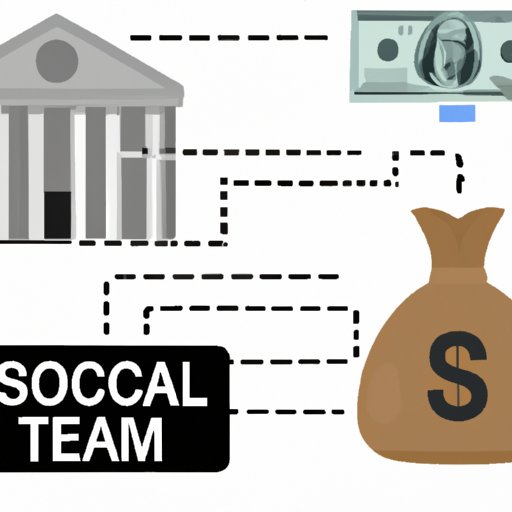
Introduction
Sending money to a federal inmate can be a daunting task, but it’s an important one. It’s one way we can support our loved ones who are currently incarcerated. Access to funds is crucial for inmates, especially as they try to maintain contact with their families, purchase necessary items, and prepare for re-entry into society. In this article, we’ll provide you with a comprehensive guide to sending money to federal inmates, so you can navigate the system with confidence.
Step-by-Step Guide
Sending money to a federal inmate is actually quite straightforward. Here’s a step-by-step process:
1. Collect the necessary information about the inmate, including their full name, inmate number, and the name and location of the prison where they are being held.
2. Choose a payment option. Money can be sent through online accounts, money order, Western Union, MoneyGram, or wire transfer.
3. Choose the amount of money you wish to send. There are limits and fees associated with each payment option, so it’s essential to check the details before making the transaction.
4. Submit the payment, providing accurate information about both you and the inmate.
5. Keep a record of the transaction for your reference, including the confirmation number and tracking information.
It’s important to remember that different federal institutions may have specific policies and guidelines in place, so it’s always wise to double-check the instructions provided by the prison.
Best Practices
There are some best practices to keep in mind when sending money to a federal inmate. First and foremost, it’s critical to avoid scams. Always be cautious when responding to requests for money, as there are many scammers out there targeting those with loved ones behind bars. Secondly, ensure that the payment method you choose is reliable and secure. It’s worth checking the reputation of the payment provider and reading reviews from verified customers.
In addition to avoiding scams and selecting the right payment method, it’s essential to follow the institutional guidelines for sending money. These guidelines may include restrictions on the amount of money that can be sent at once or even the types of payment accepted. Following these guidelines not only ensures your transaction goes smoothly, but it also helps to keep the institution safe by preventing illegal activities and protecting inmates from undue influence.
Finally, it’s essential to verify the details of the inmate before sending money. If someone other than the inmate is trying to collect the funds, it may be a red flag, so be sure to check with the appropriate authorities before making a transaction.
Comparison of Payment Options
There are several payment options available when sending money to a federal inmate, each with advantages and disadvantages.
Online accounts are a popular option because they are convenient and easy to use. They can be accessed 24/7, and funds can be transferred instantly. However, there may be fees associated with the transaction, and always check if the facility you are sending to accepts online accounts.
Money orders are also a popular option because they are easy to obtain, and the fees are often lower than other payment options. They also have a straightforward paper trail that can easily trace and document the transaction. However, they can take longer to arrive than other methods.
Western Union and MoneyGram are other payment options that provide quick and reliable service. Though they may be more expensive compared to other options, they provide peace of mind due to their years of excellent service and customer support.
Wire transfers offer the safest and quickest method of sending money. Though they can be expensive to conduct compared to other payment options, they are very reliable in ensuring the money safely arrives to the intended inmate.
Trends and Developments
Technology and regulations are making it easier and more secure to send money to federal inmates. In recent years, online accounts have been gaining popularity, and numerous institutions have started utilizing electronic tabs to facilitate transactions. Additionally, recent changes in legislation have facilitated the use of electronic payments systems to send money to inmates.
New payment options are continually coming into existence, enabling users to transfer funds efficiently and securely. Due to the high demand driven by an increasing population of inmates, payment providers are constantly developing new services to make the process smoother and hassle-free.
Case Studies
Sending money to federal inmates has a significant impact on both the inmates and the families and communities that support them. It is always essential to ensure that the process is smooth, secure and with compliance with institutional guidelines.
Case studies have shown that access to funds via family support significantly decreases the stress faced by inmates. Especially during times of unexpected challenges, such as medical bills or emergency family needs, having support from their families goes a long way in stabilizing them and increasing their quality of life. These interactions enable them to procure personal needs, talk to their loved ones on the phone, and buy commissary items amongst others.
IHNTG (I Have No Tomorrow Ganges), a non-profit agency has been empowering children and young adults on the streets to turn away from gang violence and towards a bright future. Members of the agency have reported that donating money to inmates ensures that inmates support their families which can provide a greater likelihood of the children and young adults staying away from gang activity.
Conclusion
Sending money to federal inmates is an important way to offer support to our loved ones who are currently incarcerated. By following guidelines, avoiding scams and selecting the best payment option for your needs, you can make the process more secure and straightforward. Though each payment option has its pros and cons, there are no limits to the impact a little support can have on the emotional and rehabilitation journey of the inmates.
We encourage readers to share their experiences and tips on the process of sending money to federal inmates so that we can continue to improve and share knowledge.





